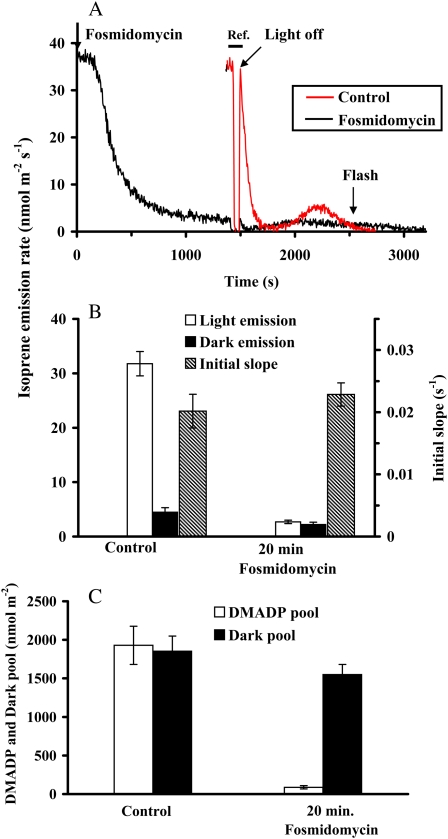Figure 7.
A sample response of the kinetics of the fosmidomycin effect on isoprene emission (black line) and comparison with the kinetics of isoprene release without fosmidomycin (red line; A), the influence of fosmidomycin on the steady-state isoprene emission in the light and on the maximum dark-induced isoprene emission, as well as the rate constant of isoprene synthase (B), and on the corresponding DMADP and dark pool sizes (C). In A, both the experiments without and with fosmidomycin were conducted with the same leaf. The experiment without fosmidomycin was conducted first, and after the leaf had reached the steady state again following the transient (20–30 min after switching on the light again), 20 μm aqueous solution of fosmidomycin was applied (time 0) and the reduction of isoprene emission was monitored in light until an apparent steady state was reached. At 1,350 to 1,450 s, the reference line was measured (Ref.; horizontal bar), and at 1,450 s, the light/dark transient was carried out according to the standard protocol (Fig. 1). A 2-s pulse of light (600 μmol m−2 s−1) was given at 2,550 s. To facilitate visual examination of the patterns, the transient without fosmidomycin was overlaid to the fosmidomycin experiment such that the moment of leaf darkening was exactly synchronized in both experiments. In this experiment, the dark pool size was 2,120 nmol m−2 prior to fosmidomycin feeding (red line) and 1,680 nmol m−2 after feeding (black line). In B and C, data are averages ± sd of four replicate experiments. All environmental conditions are as in Figure 2.

